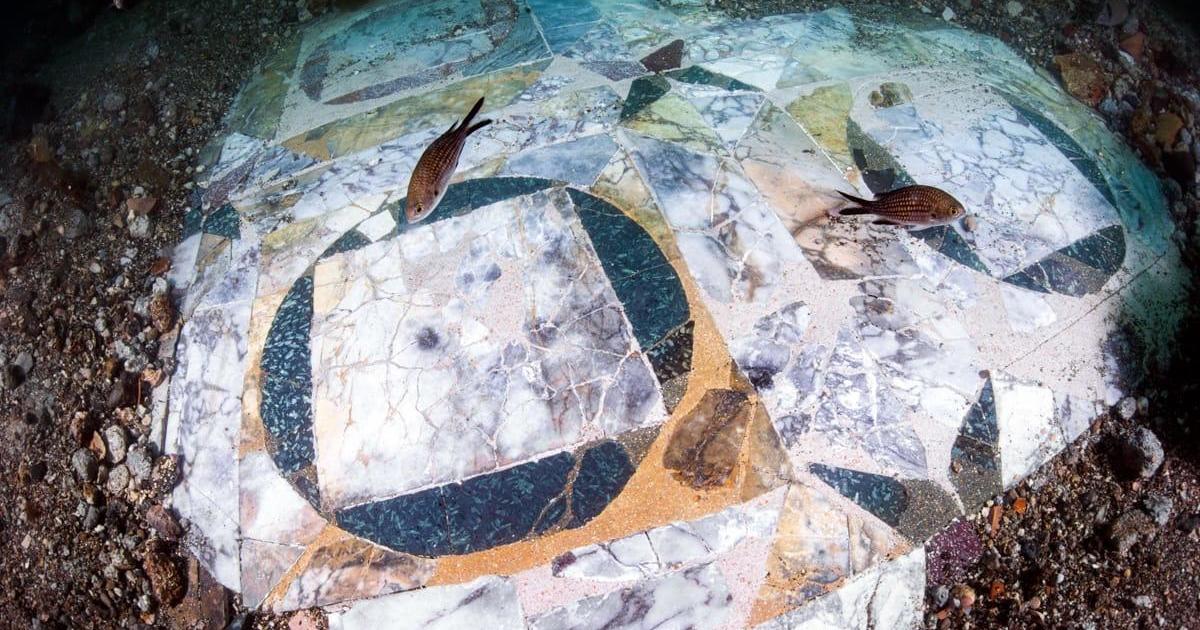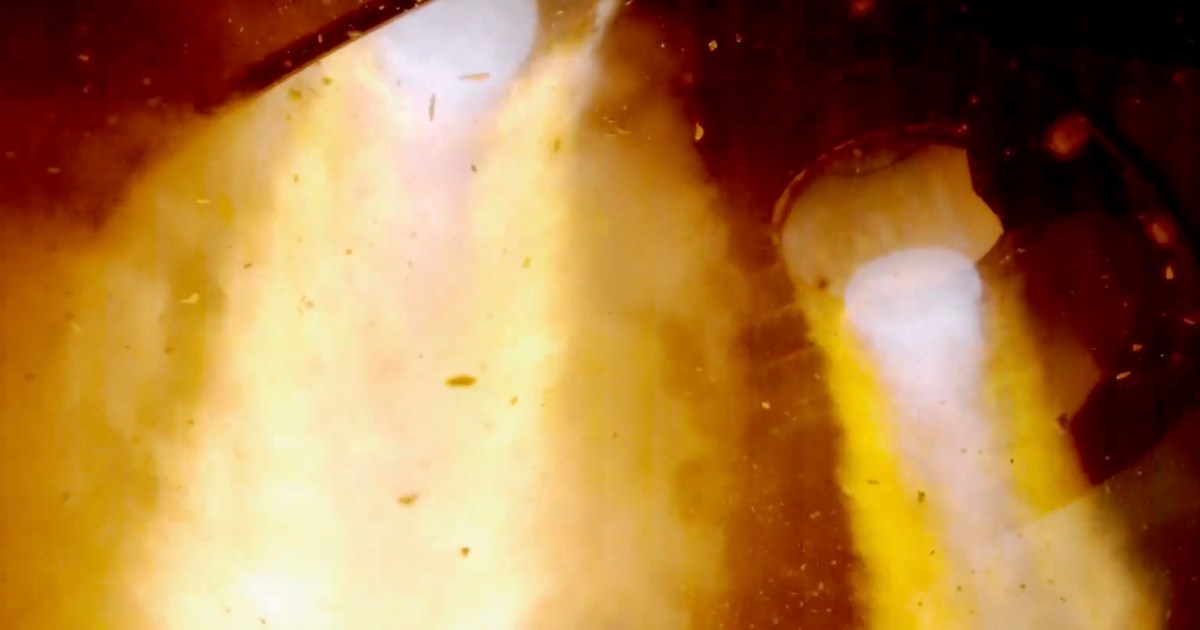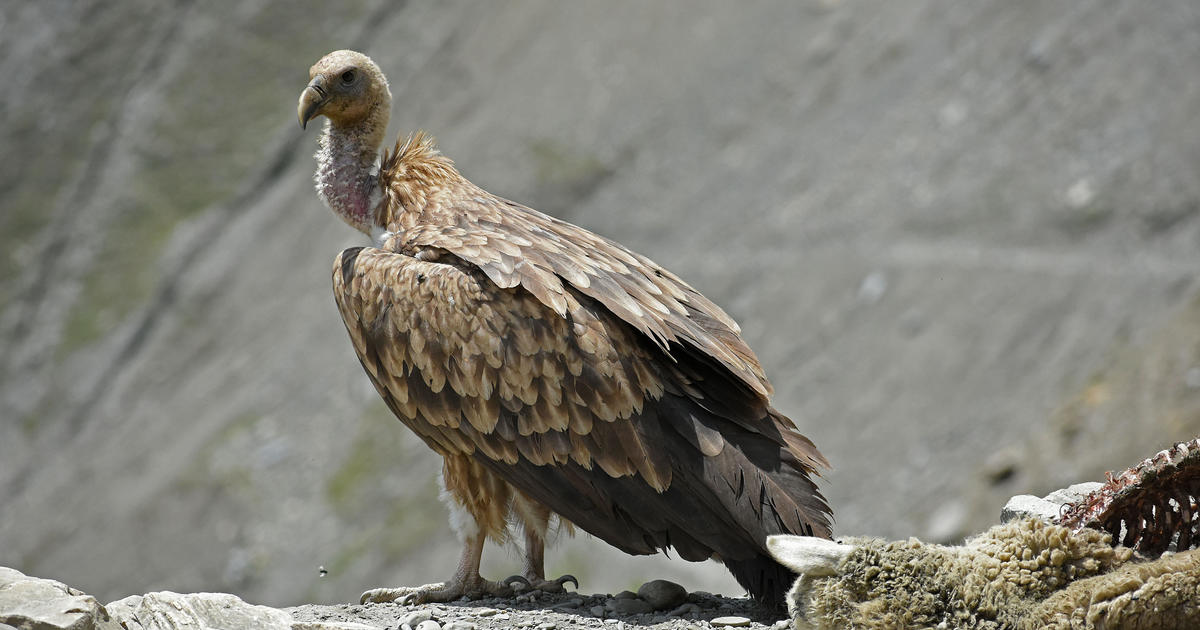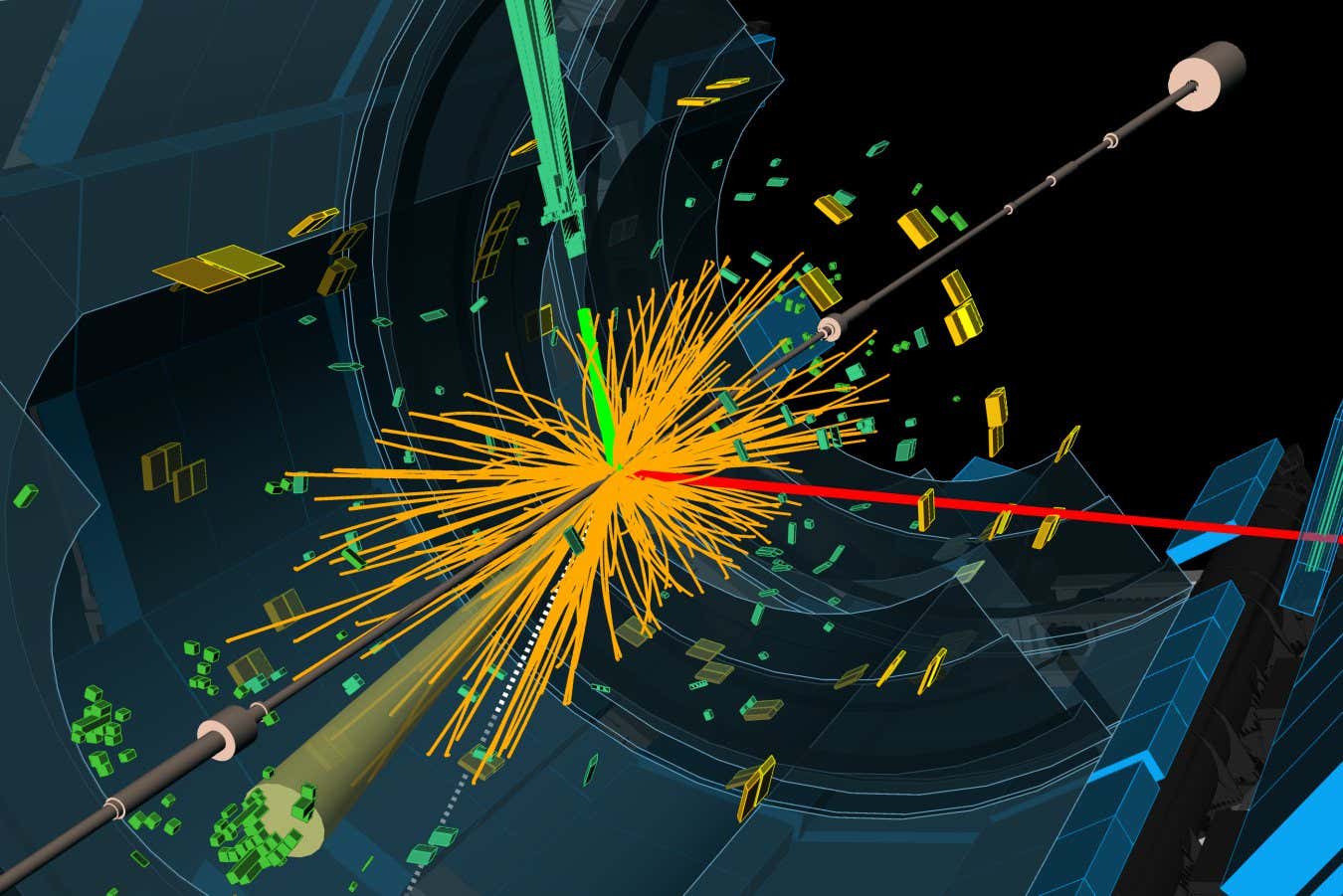Technology
AI and stand up comedy

 Dahlia Katz
Dahlia Katz“Why did the politician bring a ladder to the debate? To make sure he could reach new heights with his promises!”
Ask AI to write a political joke, and the above is an example of what you can get.
Perhaps not funny enough to deliver on stage in front of a paying audience, but that doesn’t mean there is no room for AI in comedy.
Comedians are increasingly experimenting with the technology to write scripts and brainstorm ideas, including Anesti Danelis. Earlier this year, the Canadian asked popular AI chatbot ChatGPT to write him a show.
The result is what he has been performing throughout this summer, including at this month’s Edinburgh Festival Fringe.
The BBC sat down with Anesti after his sixth performance in seven days at the Toronto Fringe Theatre Festival in July. He explained the writing process behind his show “Artificially Intelligent”.
“I was playing around with ChatGPT, and the results it gave me were terribly hilarious, and I thought ‘maybe there’s a show in this?’.”
Despite some rubbish jokes, he says the tool was useful for brainstorming.
“I asked it to ‘write me five songs about bisexual dilemmas’, or ‘being an immigrant child’, and it gave me ideas that I would have never thought of.”
What he wasn’t expecting from AI was its understanding of how to devise a show.
“I told it to make me a running order, and it explained where every song should go and why, and it made total sense. I was surprised by how much it could explain the reasoning behind it.”
Despite using the technology to write chunks of the script, Anesti’s show very much relies on his delivery. Throughout the performance the comedian switches from a keyboard to a guitar to deliver songs and monologues. There’s lots of interaction, including a serenading of an audience member, with a song written about them by ChatGPT.
Reflecting on the experience, Anesti says: “I learned through the process that human creativity can’t be replicated or replaced, and in the end about 20% of the show was pure AI, and the other 80% was a mix.”
 Getty Images
Getty ImagesSo far, he says, he has only had good feedback from audience members, including Olivia Smith and Bethany Radford, who both live in Toronto.
Olivia admits she’s sceptical of AI, but enjoyed seeing it played with creatively.
“I think I’d feel a little cheated out of an experience if the entire thing was written by technology, but it was funny seeing AI on stage because it was creative,” she says.
Bethany, who is an actor, agrees, and says: “There is a place for AI in creation and writing so long as it’s transparent that it’s been part of the process.”
A recently released study from the University of Southern California found that AI-generated jokes outperform those crafted by human beings. Bethany, however, is not so sure, and feels “humans are pretty good at sniffing out AI”.
If she is watching something, she adds: “I feel like I know when the writing had no human involved. But I’m sure that will change as it gets smarter.”
Making audiences laugh is big business, and over the past decade the stand-up comedy market in the US has almost tripled in terms of the combined value of tickets sold. That is according to data from trade publication Pollstar, which monitors the live performance sector. It says US comedy ticket sales hit $900m (£700m) in 2023, up from $371m in 2012.
Meanwhile, a separate study last month said that live comedy was now worth more than £1bn a year to the UK economy. This figure includes not just ticket sales, but also the revenues of comedy venues and festivals, and the positive impact on the wider local economies.
US comedian Viv Ford is also performing at this month’s Edinburgh Festival Fringe.
Her show is called “No Kids On The Blockchain”, and details her time living with “14 tech-loving crypto [currency] bros in San Francisco”.
Though she wrote the show herself, she explains she tested her material on ChatGPT.
“I’ll say, ‘hey, is this joke funny?’. And if it says ‘it’s funny’, genuinely, it does not land with an audience,” says Viv. “But if it says a joke ‘is offensive’ it does so well.
“And sometimes ChatGPT will say ‘the joke is fine, but could use some work’, in which case I toss it away and start again.”
Viv knows that lots of people won’t be so embracing of AI in the arts. It’s a view she used to take until she lived in San Francisco, where so many tech firms are based.
“I’m so aware that the only reason I think this way is because of my four-year indoctrination in the school of San Francisco,” she says. “I realised AI can be your weapon, just like Google can be your weapon. If you know how to use AI correctly, you are unstoppable.”
 Viv Ford
Viv FordNot everyone in the comedy world is keen to try AI though, including Kiwi-Filipino comedian James Roque. He says it doesn’t fit with his approach to humour.
“My belief and ethos is that the best comedy is the kind that is deeply human and vulnerable, and AI couldn’t do that,” he says.
Mr Roque is also performing at Edinburgh this month, and he thinks audiences will notice if other comedians use AI. “They can sniff out when something isn’t authentic,” he says.
“So if you haven’t created it, I think audiences are smart and emotionally intelligent enough to know something is off in the show.”
Could AI be the future of comedy? No one can be sure.
Despite writing the majority of his current show with AI, Anesti Danelis isn’t convinced he would do it again. He also has concerns for the next generation of comedians who might grow to rely on it.
“I think the dangerous thing about AI is that it can be a crutch,” he explains.
“If you’re an established comedian who knows your voice, AI gives good advice. But when you’re a new comedian and you don’t have that voice yet, you need to learn without AI.
“Otherwise, a generation of comedians will be saying the same repetitive, distilled stuff.”
Technology
Quantum computers teleport and store energy harvested from empty space


A quantum computing chip
IBM
Energy cannot be created from nothing, but physicists found a way to do the next best thing: extract energy from seemingly empty space, teleport it elsewhere and store it for later use. The researchers successfully tested their protocol using a quantum computer.
The laws of quantum physics reveal that perfectly empty space cannot exist – even places fully devoid of atoms still contain tiny flickers of quantum fields. In 2008, Masahiro Hotta at Tohoku University in Japan proposed that those flickers, together with the …
Science & Environment
What caused the hydrothermal explosion at Yellowstone National Park? A meteorologist explains

Yellowstone National Park visitors were sent running and screaming Tuesday when a hydrothermal explosion spewed boiling hot water and rocks into the air. No one was injured, but it has left some wondering: How does this happen and why wasn’t there any warning?
The Weather Channel’s Stephanie Abrams said explosions like this are caused by underground channels of hot water, which also create Yellowstone’s iconic geysers and hot springs.
“When the pressure rapidly drops in a localized spot, it actually forces the hot water to quickly turn to steam, triggering a hydrothermal explosion since gas takes up more space than liquid,” Abrams said Wednesday on “CBS Mornings.” “And this explosion can rupture the surface, sending mud and debris thousands of feet up and more than half a mile out in the most extreme cases.”
Tuesday’s explosion was not that big, Abrams said, “but a massive amount of rocks and dirt buried the Biscuit Basin,” where the explosion occurred.
A nearby boardwalk was left with a broken fence and was covered in debris. Nearby trees were also killed, with the U.S. Geological Survey saying the plants “can’t stand thermal activity.”
“Because areas heat up and cool down over time, trees will sometimes die out when an area heats up, regrow as it cools down, but then die again when it heats up,” the agency said on X.
The USGS said it considers this explosion small, and that similar explosions happen in the national park “perhaps a couple times a year.” Often, though, they happen in the backcountry and aren’t noticed.
“It was small compared to what Yellowstone is capable of,” USGS Volcanoes said on X. “That’s not to say it was not dramatic or very hazardous — obviously it was. But the big ones leave craters hundreds of feet across.”
The agency also said that “hydrothermal explosions, “being episodes of water suddenly flashing to steam, are notoriously hard to predict” and “may not give warning signs at all.” It likened the eruptions to a pressure cooker.
While Yellowstone sits on a dormant volcano, officials said the explosion was not related to volcanic activity.
“This was an isolated incident in the shallow hot-water system beneath Biscuit Basin,” the USGS said. “It was not triggered by any volcanic activity.”
Technology
What happened to the Metaverse?

S6
Ep135

What happened to the Metaverse?
Host Andrew Davidson is joined by technology experts Brian Benway and Jan Urbanek in a discussion about the Metaverse. Our experts shed light on the latest technological and hardware advancements and marketing strategies from Big Tech. What will it take for the Metaverse to gain mainstream popularity? Listen now to find out!
Head over to Mintel’s LinkedIn to let us know what you think of today’s episode, and visit mintel.com to become a member of our free Spotlight community.
Visit the Mintel Store to explore all our technology research and buy a report today.
Meet the Host

Andrew Davidson
SVP/Chief Insights Officer, Mintel Comperemedia.
Meet the Guests

Brian Benway
Senior Analyst, Gaming and Entertainment, Mintel Reports US.

Jan Urbanek
Senior Analyst, Consumer Technology, Mintel Reports Germany.
Mintel News
For the latest in consumer and industry news, top trends and market perspectives, stay tuned to Mintel News featuring commentary from Mintel’s team of global category analysts.
More from Mintel
-
Mintel Technology Reports
Mintel’s Technology market research help you anticipate what’s next in the Technology industries….
-
Global Outlook on Sustainability: A Consumer Study 2024-25
Get the latest sustainability data, with insights on consumers, products and markets to inform your innovation strategy and build your sustainability strategy….
Podcast
2024-03-15T03:16:00+00:00
2024
0
Latest insights
June 6, 2024
In the exciting world of Artificial Intelligence (AI), prompts are instructions or queries you enter into the AI interface to get responses. If you want helpful responses, you…
November 28, 2023
Head over to Mintel’s LinkedIn to let us know what you think of today’s episode, and visit mintel.com to become a member of our free Spotlight community. Learn…
Download the Latest Market Intelligence
Science & Environment
Archaeologists make stunning underwater discovery of ancient mosaic in sea off Italy

Researchers studying an underwater city in Italy say they have found an ancient mosaic floor that was once the base of a Roman villa, a discovery that the local mayor called “stupendous.”
The discovery was made in Bay Sommersa, a marine-protected area and UNESCO World Heritage Site off the northern coast of the Gulf of Naples. The area was once the Roman city of Baia, but it has become submerged over the centuries thanks to volcanic activity in the area. The underwater structures remain somewhat intact, allowing researchers to make discoveries like the mosaic floor.
The Campi Flegrei Archaeological Park announced the latest discovery, which includes “thousands of marble slabs” in “hundreds of different shapes,” on social media.
“This marble floor has been at the center of the largest underwater restoration work,” the park said, calling the research “a new challenge” and made “very complicated due to the extreme fragment of the remains and their large expansion.”
The marble floor is made of recovered, second-hand marble that had previously been used to decorate other floors or walls, the park said. Each piece of marble was sharpened into a square and inscribed with circles. The floor is likely from the third century A.D., the park said in another post, citing the style of the room and the repurposing of the materials as practices that were common during that time.
Researchers are working carefully to extract the marble pieces from the site, the park said. The recovery work will require careful digging around collapsed walls and other fragmented slabs, but researchers hope to “be able to save some of the geometries.”
Once recovered, the slabs are being brought to land and cleaned in freshwater tanks. The marble pieces are then being studied “slab by slab” to try to recreate the former mosaic, the park said.
“The work is still long and complex, but we are sure that it will offer many prompts and great satisfactions,” the park said.
Technology
SpaceX fires up Starship engines ahead of fifth test flight


SpaceX has just performed a static fire of the six engines on its Starship spacecraft as it awaits permission from the Federal Aviation Administration (FAA) for the fifth test flight of the world’s most powerful rocket.
The Elon Musk-led spaceflight company shared footage and an image of the test fire on X (formerly Twitter) on Thursday. It shows the engines firing up while the vehicle remained on the ground.
Six engine static fire of Flight 6 Starship pic.twitter.com/fzJz9BWBn6
— SpaceX (@SpaceX) September 19, 2024
For flights, the Starship spacecraft is carried to orbit by the first-stage Super Heavy booster, which pumps out 17 million pounds of thrust at launch, making it the most powerful rocket ever built.
The Super Heavy booster and Starship spacecraft — collectively known as the Starship — have launched four times to date, with the performance of each test flight showing improvements over the previous one.
The first one, for example, exploded shortly after lift off from SpaceX’s Starbase facility in Boca Chica, Texas, in April last year, while the second effort, which took place seven months later, achieved stage separation before an explosion occurred — an incident that was captured in dramatic footage. The third and fourth flights lasted much longer and achieved many of the mission objectives, including getting the Starship spacecraft to orbit.
The fifth test flight isn’t likely to take place until November at the earliest, according to a recent report. It will involve the first attempt to use giant mechanical arms to “catch” the Super Heavy booster as it returns to the launch area. SpaceX recently expressed extreme disappointment at the time that it’s taking the FAA to complete an investigation that will pave the way for the fifth Starship test, and has said that it’ll be ready to launch the vehicle within days of getting permission from the FAA.
Once testing is complete, NASA wants to use the Starship, along with its own Space Launch System rocket, to launch crew and cargo to the moon and quite possibly for destinations much further into space such as Mars. NASA is already planning to use a modified version of the Starship spacecraft to land the first astronauts in five decades on the lunar surface in the Artemis III mission, currently set for 2026.
Science & Environment
Painkiller used in cattle wiped out India’s vultures, and scientists say that led to 500,000 human deaths

New Delhi — Scientists say Indian farmers’ eager uptake of a painkiller for their cattle in the 1990s has led to the inadvertent deaths of half of a million people and massive economic losses — not from any harm to the cattle, but from the loss of millions of vultures, scavengers that historically devoured animals’ remains before they could rot and become vectors for disease.
In early 1990s, the patent on a painkiller called diclofenac lifted, making it cheap and widely available for India’s massive agricultural sector. Farmers use it to treat a wide array of conditions in cattle. But even a small amount of the drug is fatal to vultures. Since the beginning of its widespread use in India, the domestic vulture population has dropped from a whopping 50 million to just a few thousand — and according to a study published by the American Economic Association, the impact on humans has been monumental, reflecting the vital role the scavengers play.
Vultures have been a crucial part of India’s ecosystems for centuries. According to the authors of the study, entitled “The Social Costs of Keystone Species Collapse: Evidence From The Decline of Vultures in India,” the large, homely birds are a “keystone species” — one that plays an irreplaceable role in an ecosystem.
They’re the only scavengers that feed entirely on carcasses, and they do it extremely efficiently, quickly devouring the remains and leaving little behind to spread disease. The study authors say India’s vultures would typically eat at least 50 million animal carcasses every year, before their population was decimated.
In doing so, they prevented the dead farm animals from rotting, and the deadly bacteria and other pathogens that thrive in carcasses from being transmitted into human populations.
“In a country like India with prohibitions on eating beef, most cattle end up turning into carcasses,” Anant Sudarshan, an associate professor of economics at the University of Warwick in England, who co-authored the study, told CBS News. “Vultures provide an incredible disposal service for free. … A group of vultures takes about 45 minutes to turn a cow carcass into bone.”
The vultures’ keen appetite also helped keep the populations of competing scavengers in check, such as feral dogs and rats, which can transmit rabies and a host of other diseases.
In 1994, farmers began giving diclofenac to their cattle and other livestock. The drug causes kidney failure and death in vultures that feed on the carcasses of animals given the painkiller, and the population of the birds shrank from 50 million to just 20,000 over the course of the ensuing decade alone.
Without the vultures around to do the job, farmers started disposing their dead livestock in local bodies of water, which caused water pollution — and another way for pathogens to reach humans.
Sudarshan and study co-author Eyal Frank, an environmental economist at the University of Chicago Harris School of Public Policy, examined the impact of the drastically reduced vulture population on human health by mapping vulture habitats with health data from more than 600 districts in India. They said their research shows 100,000 human deaths every year between 2000 and 2005 could be linked with the decreased vulture populations.
It also shows economic losses they estimated at $69 billion per year, largely associated with premature human deaths due to the collapse of the scavenger population.
These deaths were caused, according to their research, by the spread of diseases that a thriving vulture population would have mitigated. Stray dog populations, and with them, the spread of rabies, also increased during the timeframe, as did the amount of bacteria measured in many local water sources.
“India is now the largest center of rabies in the world, as the feral dog population has grown dramatically,” Sudarshan told CBS News.
Without a major vulture rebound, the study authors said the spread of disease and resulting deaths will only continue in the coming years, as will the costs associated with health care.
India did ban diclofenac for veterinary use in 2006, but Sudarshan said the ban needs to be enforced much more effectively. He and Eyal have called for more conservation funding to boost vulture populations, but they’ve warned that even if the Indian government does mount a major effort, it will take at least a decade for the species to bounce back to the extent required because they’re “slow reproducers.”
As an alternative to bringing the vultures back, Sudarshan said India could build a network of incinerators around the country, but the estimated cost of that is about $1 billion per year, and they would use a huge amount of energy and create considerable air pollution, which is already a major problem for India.
“So, it makes more sense to bring back the natural way of dealing with the millions of animal carcasses that India produces each year,” he said.
And he said that work must start urgently, as the “vultures began dying in the 1990s. India has not done anything three decades on.”
The government does spend about $3 million per year to save India’s native tigers. Sudarshan said while vultures may be far less of a tourist attraction, there’s a broader question about “the basis of our conservation policy.”
“Our paper shows that the cost of losing them [vultures] is about $69 billion a year, which is far higher than any benefits the tiger” brings, he said, adding: “We need to think from a cost effectiveness point of view and growth view, how should we pick species to conserve?”
“Understanding the role vultures play in human health underscores the importance of protecting wildlife – and not just the cute and cuddly,” said his co-author, Frank. “They all have a job to do in our ecosystems that impacts our lives.”
-

 Sport10 hours ago
Sport10 hours agoJoshua vs Dubois: Chris Eubank Jr says ‘AJ’ could beat Tyson Fury and any other heavyweight in the world
-

 News1 day ago
News1 day agoYou’re a Hypocrite, And So Am I
-

 News11 hours ago
News11 hours agoIsrael strikes Lebanese targets as Hizbollah chief warns of ‘red lines’ crossed
-

 Sport10 hours ago
Sport10 hours agoUFC Edmonton fight card revealed, including Brandon Moreno vs. Amir Albazi headliner
-

 Technology9 hours ago
Technology9 hours agoiPhone 15 Pro Max Camera Review: Depth and Reach
-

 Science & Environment13 hours ago
Science & Environment13 hours agoHow one theory ties together everything we know about the universe
-

 Science & Environment21 hours ago
Science & Environment21 hours agoSunlight-trapping device can generate temperatures over 1000°C
-

 News8 hours ago
News8 hours agoBrian Tyree Henry on voicing young Megatron, his love for villain roles
-

 Science & Environment1 day ago
Science & Environment1 day agoQuantum time travel: The experiment to ‘send a particle into the past’
-

 CryptoCurrency10 hours ago
CryptoCurrency10 hours ago2 auditors miss $27M Penpie flaw, Pythia’s ‘claim rewards’ bug: Crypto-Sec
-

 CryptoCurrency10 hours ago
CryptoCurrency10 hours agoBitcoin miners steamrolled after electricity thefts, exchange ‘closure’ scam: Asia Express
-

 CryptoCurrency10 hours ago
CryptoCurrency10 hours agoCardano founder to meet Argentina president Javier Milei
-

 CryptoCurrency10 hours ago
CryptoCurrency10 hours agoDorsey’s ‘marketplace of algorithms’ could fix social media… so why hasn’t it?
-

 CryptoCurrency10 hours ago
CryptoCurrency10 hours agoLow users, sex predators kill Korean metaverses, 3AC sues Terra: Asia Express
-
Business9 hours ago
How Labour donor’s largesse tarnished government’s squeaky clean image
-

 Science & Environment13 hours ago
Science & Environment13 hours ago‘Running of the bulls’ festival crowds move like charged particles
-

 CryptoCurrency9 hours ago
CryptoCurrency9 hours agoEthereum is a 'contrarian bet' into 2025, says Bitwise exec
-

 Science & Environment13 hours ago
Science & Environment13 hours agoRethinking space and time could let us do away with dark matter
-

 Science & Environment10 hours ago
Science & Environment10 hours agoWe may have spotted a parallel universe going backwards in time
-

 CryptoCurrency10 hours ago
CryptoCurrency10 hours agoArthur Hayes’ ‘sub $50K’ Bitcoin call, Mt. Gox CEO’s new exchange, and more: Hodler’s Digest, Sept. 1 – 7
-

 CryptoCurrency10 hours ago
CryptoCurrency10 hours agoTreason in Taiwan paid in Tether, East’s crypto exchange resurgence: Asia Express
-

 CryptoCurrency10 hours ago
CryptoCurrency10 hours agoLeaked Chainalysis video suggests Monero transactions may be traceable
-

 CryptoCurrency10 hours ago
CryptoCurrency10 hours agoJourneys: Robby Yung on Animoca’s Web3 investments, TON and the Mocaverse
-

 CryptoCurrency10 hours ago
CryptoCurrency10 hours agoLouisiana takes first crypto payment over Bitcoin Lightning
-

 CryptoCurrency10 hours ago
CryptoCurrency10 hours agoAre there ‘too many’ blockchains for gaming? Sui’s randomness feature: Web3 Gamer
-

 CryptoCurrency10 hours ago
CryptoCurrency10 hours agoCrypto whales like Humpy are gaming DAO votes — but there are solutions
-

 CryptoCurrency10 hours ago
CryptoCurrency10 hours agoHelp! My parents are addicted to Pi Network crypto tapper
-

 CryptoCurrency10 hours ago
CryptoCurrency10 hours ago$12.1M fraud suspect with ‘new face’ arrested, crypto scam boiler rooms busted: Asia Express
-

 CryptoCurrency10 hours ago
CryptoCurrency10 hours ago‘Everything feels like it’s going to shit’: Peter McCormack reveals new podcast
-

 Science & Environment13 hours ago
Science & Environment13 hours agoFuture of fusion: How the UK’s JET reactor paved the way for ITER
-

 CryptoCurrency10 hours ago
CryptoCurrency10 hours agoSEC sues ‘fake’ crypto exchanges in first action on pig butchering scams
-

 CryptoCurrency10 hours ago
CryptoCurrency10 hours agoFed rate cut may be politically motivated, will increase inflation: Arthur Hayes
-

 CryptoCurrency10 hours ago
CryptoCurrency10 hours agoDecentraland X account hacked, phishing scam targets MANA airdrop
-

 CryptoCurrency10 hours ago
CryptoCurrency10 hours agoCZ and Binance face new lawsuit, RFK Jr suspends campaign, and more: Hodler’s Digest Aug. 18 – 24
-

 CryptoCurrency10 hours ago
CryptoCurrency10 hours agoCertiK Ventures discloses $45M investment plan to boost Web3
-

 CryptoCurrency10 hours ago
CryptoCurrency10 hours agoMemecoins not the ‘right move’ for celebs, but DApps might be — Skale Labs CMO
-

 CryptoCurrency10 hours ago
CryptoCurrency10 hours agoTelegram bot Banana Gun’s users drained of over $1.9M
-

 CryptoCurrency10 hours ago
CryptoCurrency10 hours agoDZ Bank partners with Boerse Stuttgart for crypto trading
-

 CryptoCurrency10 hours ago
CryptoCurrency10 hours agoRedStone integrates first oracle price feeds on TON blockchain
-

 CryptoCurrency10 hours ago
CryptoCurrency10 hours agoBitcoin bulls target $64K BTC price hurdle as US stocks eye new record
-

 CryptoCurrency10 hours ago
CryptoCurrency10 hours agoSEC asks court for four months to produce documents for Coinbase
-

 CryptoCurrency10 hours ago
CryptoCurrency10 hours ago‘No matter how bad it gets, there’s a lot going on with NFTs’: 24 Hours of Art, NFT Creator
-

 CryptoCurrency10 hours ago
CryptoCurrency10 hours agoBlockdaemon mulls 2026 IPO: Report
-
Business10 hours ago
Thames Water seeks extension on debt terms to avoid renationalisation
-

 Politics9 hours ago
Politics9 hours agoI’m in control, says Keir Starmer after Sue Gray pay leaks
-

 News8 hours ago
News8 hours ago“Beast Games” contestants sue MrBeast’s production company over “chronic mistreatment”
-

 News8 hours ago
News8 hours agoSean “Diddy” Combs denied bail again in federal sex trafficking case in New York
-

 News8 hours ago
News8 hours agoBrian Tyree Henry on his love for playing villains ahead of “Transformers One” release
-

 News8 hours ago
News8 hours agoBrian Tyree Henry on voicing young Megatron, his love for villain roles
-

 CryptoCurrency8 hours ago
CryptoCurrency8 hours agoCoinbase’s cbBTC surges to third-largest wrapped BTC token in just one week
-

 Technology3 days ago
Technology3 days agoYouTube restricts teenager access to fitness videos
-

 Politics1 day ago
Politics1 day agoWhat is the House of Lords, how does it work and how is it changing?
-

 Politics1 day ago
Politics1 day agoKeir Starmer facing flashpoints with the trade unions
-

 Health & fitness2 days ago
Health & fitness2 days agoWhy you should take a cheat day from your diet, and how many calories to eat
-

 Science & Environment1 day ago
Science & Environment1 day agoElon Musk’s SpaceX contracted to destroy retired space station
-

 MMA10 hours ago
MMA10 hours agoUFC’s Cory Sandhagen says Deiveson Figueiredo turned down fight offer
-

 MMA10 hours ago
MMA10 hours agoDiego Lopes declines Movsar Evloev’s request to step in at UFC 307
-

 Football10 hours ago
Football10 hours agoNiamh Charles: Chelsea defender has successful shoulder surgery
-

 Football10 hours ago
Football10 hours agoSlot's midfield tweak key to Liverpool victory in Milan
-

 Science & Environment13 hours ago
Science & Environment13 hours agoHow to wrap your head around the most mind-bending theories of reality
-

 Technology2 days ago
Technology2 days agoCan technology fix the ‘broken’ concert ticketing system?
-

 Fashion Models9 hours ago
Fashion Models9 hours agoMiranda Kerr nude
-

 Fashion Models9 hours ago
Fashion Models9 hours ago“Playmate of the Year” magazine covers of Playboy from 1971–1980
-

 Politics9 hours ago
Politics9 hours agoLabour MP urges UK government to nationalise Grangemouth refinery
-

 Technology2 days ago
Technology2 days agoWhat will future aerial dogfights look like?
-

 Science & Environment12 hours ago
Science & Environment12 hours agoOdd quantum property may let us chill things closer to absolute zero
-

 Entertainment8 hours ago
Entertainment8 hours ago“Jimmy Carter 100” concert celebrates former president’s 100th birthday
-

 CryptoCurrency10 hours ago
CryptoCurrency10 hours agoSEC settles with Rari Capital over DeFi pools, unregistered broker activity
-

 News8 hours ago
News8 hours agoJoe Posnanski revisits iconic football moments in new book, “Why We Love Football”
-

 Health & fitness2 days ago
Health & fitness2 days agoHow to adopt mindful drinking in 2022
-

 Health & fitness2 days ago
Health & fitness2 days agoWhat 10 days of a clean eating plan actually does to your body and why to adopt this diet in 2022
-

 Health & fitness2 days ago
Health & fitness2 days agoWhen Britons need GoFundMe to pay for surgery, it’s clear the NHS backlog is a political time bomb
-

 Health & fitness2 days ago
Health & fitness2 days agoThe maps that could hold the secret to curing cancer
-
Health & fitness2 days ago
Covid v flu v cold and how to tell the difference between symptoms this winter
-

 Science & Environment23 hours ago
Science & Environment23 hours agoQuantum to cosmos: Why scale is vital to our understanding of reality
-

 Science & Environment1 day ago
Science & Environment1 day agoHow to wrap your mind around the real multiverse
-

 Technology3 days ago
Technology3 days agoTrump says Musk could head ‘government efficiency’ force
-

 Science & Environment2 days ago
Science & Environment2 days agoParticle physicists may have solved a strange mystery about the muon
-

 Science & Environment1 day ago
Science & Environment1 day agoTime may be an illusion created by quantum entanglement
-

 Science & Environment1 day ago
Science & Environment1 day agoHow the weird and powerful pull of black holes made me a physicist
-

 Politics23 hours ago
Politics23 hours agoIs there a £22bn ‘black hole’ in the UK’s public finances?
-

 Science & Environment23 hours ago
Science & Environment23 hours agoX-ray laser fires most powerful pulse ever recorded
-

 Science & Environment22 hours ago
Science & Environment22 hours agoWhat are fractals and how can they help us understand the world?
-

 Science & Environment22 hours ago
Science & Environment22 hours agoHow indefinite causality could lead us to a theory of quantum gravity
-

 Science & Environment21 hours ago
Science & Environment21 hours agoDoughnut-shaped swirls of laser light can be used to transmit images
-

 Science & Environment21 hours ago
Science & Environment21 hours agoBeing in two places at once could make a quantum battery charge faster
-

 Science & Environment20 hours ago
Science & Environment20 hours agoWhy we are finally within reach of a room-temperature superconductor
-

 Science & Environment19 hours ago
Science & Environment19 hours agoBlack holes scramble information – but may not be the best at it
-

 Science & Environment19 hours ago
Science & Environment19 hours agoThe galactic anomalies hinting dark matter is weirder than we thought
-

 CryptoCurrency10 hours ago
CryptoCurrency10 hours agoTelegram CEO cannot leave France, OpenSea receives Wells notice, and more: Hodler’s Digest, Aug. 25 – 31
-

 CryptoCurrency10 hours ago
CryptoCurrency10 hours agoFive crypto market predictions that haven’t come true — yet
-

 CryptoCurrency10 hours ago
CryptoCurrency10 hours agoSolana unveils new Seeker device, says it’s not just a ‘memecoin phone’
-

 CryptoCurrency10 hours ago
CryptoCurrency10 hours agoCrypto scammers orchestrate massive hack on X but barely made $8K
-

 CryptoCurrency10 hours ago
CryptoCurrency10 hours agoBitcoiners are ‘all in’ on Trump since Bitcoin ’24, but it’s getting risky
-

 CryptoCurrency10 hours ago
CryptoCurrency10 hours agoReal-world asset tokenization is the crypto killer app — Polygon exec
-

 Science & Environment13 hours ago
Science & Environment13 hours agoWhy we need to invoke philosophy to judge bizarre concepts in science
-

 Science & Environment13 hours ago
Science & Environment13 hours ago‘Sound laser’ is the most powerful ever made
-

 Science & Environment13 hours ago
Science & Environment13 hours agoJupiter’s stormy surface replicated in lab
-
Politics13 hours ago
Owen Paterson loses ECHR appeal against report that preceded downfall | Owen Paterson
-

 CryptoCurrency10 hours ago
CryptoCurrency10 hours agoBinance CEO says task force is working ‘across the clock’ to free exec in Nigeria











You must be logged in to post a comment Login